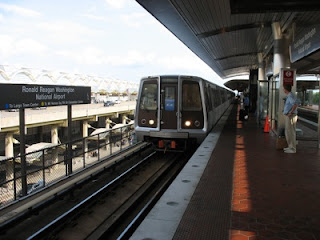 Back when Tim Kaine was governor, he handed control over the Rail-to-Dulles heavy rail project to the Metropolitan Washington Airports Authority over the objections of those who thought that a multi-state authority might not represents the interests of Virginians.
Back when Tim Kaine was governor, he handed control over the Rail-to-Dulles heavy rail project to the Metropolitan Washington Airports Authority over the objections of those who thought that a multi-state authority might not represents the interests of Virginians.
Well, it turns out that “not represent the interests of” was an under-statement. “Trample on” the interests of Virginians would be more like it. No, make that “run the interests of Virginians through the wood chipper.”
Last week the MWAA board resolved, contrary to Virginia’s long-held Right to Work law, to require any contractor winning the bid for Phase 2 of the Rail-to-Dulles project to have a labor agreement. As a Washington Examiner editorial notes, because unions represent only a tiny percentage of Virginia construction workers, most employees hired for the job will be union members from other states. Moreover, union wage rates and the lessening of competition to union-shop contractors likely will add between $350 million and $750 million to the bid.
Where will the money come for all this boodle? Let’s put it this way: It won’t come from Maryland or Washington, D.C., taxpayers, who won’t share any of the burden of funding the MWAA’s decisions. Most likely, the funds will come from drivers on the Dulles Toll Road, who have already been socked with pay for most of Phase 1. Or, who knows, maybe Virginia taxpayers generally may have to pony up.
Speaking of paying for the Rail-to-Dulles project, I have received interesting correspondence from Gary Woodward with Hurley’s Auto Audio in Tysons Corner. Tysons “landowners” are paying for a modest portion of extending Metro to their neck of the woods by means of a special tax district. But, according to Woodward, many landowners are just passing the cost on to their tenants. Writes Woodward:
“Most tenants who lease property in tysons have what is called a triple net lease. This lease is a lease in which all expenses (insurance, upkeep, management, and TAXES) are paid by the tenants. This puts the tenants who were railroaded into paying the tax (without input to the Tysons landowners) without representation. In fact we are paying the tax to develop ourselves out of a small business location. Paying for our own poison.”
Wow, this project just goes from bad to worse. This looks like an issue custom-made for Jamie Radtke, the former Tea Party chair running for the Republican nomination. It won’t work to George Allen’s favor the same way, as he championed the Rt. 288 project in Chesterfield/Henrico Counties long ago… although, I must say, the scale and abuse of that boondoggle pales in comparison to the Rail-to-Dulles fiasco, which, like everything in Northern Virginia, is bigger and more grandiose than anything in Richmond.
Watch out, Tim Kaine, you’d better get your talking points in order!
Update: After pondering this post, I do wonder if the Examiner got the whole story. Uncle Sam is helping to pay for Phase 1. Are the Phase 1 contractors required to use union-contract labor as a condition of the Davis-Bacon Act? (No, I’m not related to that Bacon.) If any federal money is being used for Phase 2, could it be that the MWAA had no choice but to comply? Does anyone know the answer?
Second update: It appears that the Examiner got the story exactly right. Read an extended (if adversarial) commentary in “The Truth about Project Labor Agreements” website. The MWAA’s action is extraordinary. I think this issue will prove to be highly damaging to Tim Kaine in his (anticipated) campaign for U.S. Senate.
Third update: I must correct an error that appeared in the original post. (I have deleted the offending passage from the post because, once corrected, it is no longer germane.) Drawing from the Examiner editorial (third paragraph, last sentence), I stated that the decision by the MWAA board to build a modified underground Metro station would add $330 million to Phase 2 of the Rail-to-Dulles project. That was incorrect. It would actually reduce the cost by $330 compared to the most recent financing plan, although the alternative selected would be roughly $330 more expensive than a cheaper, above-ground option that also had been considered.


